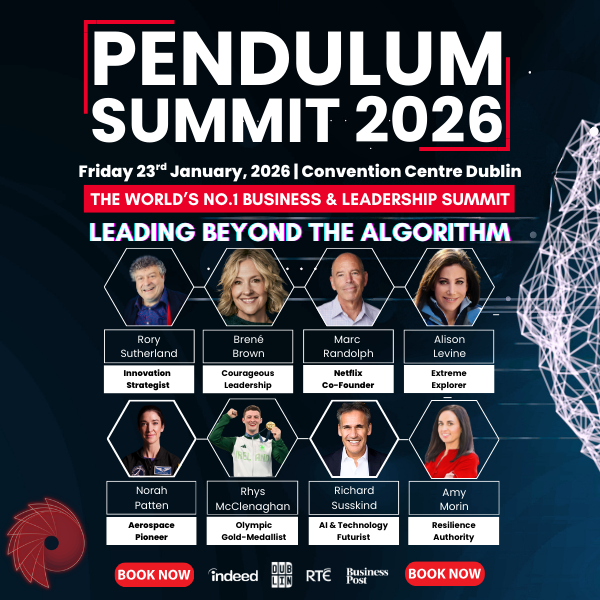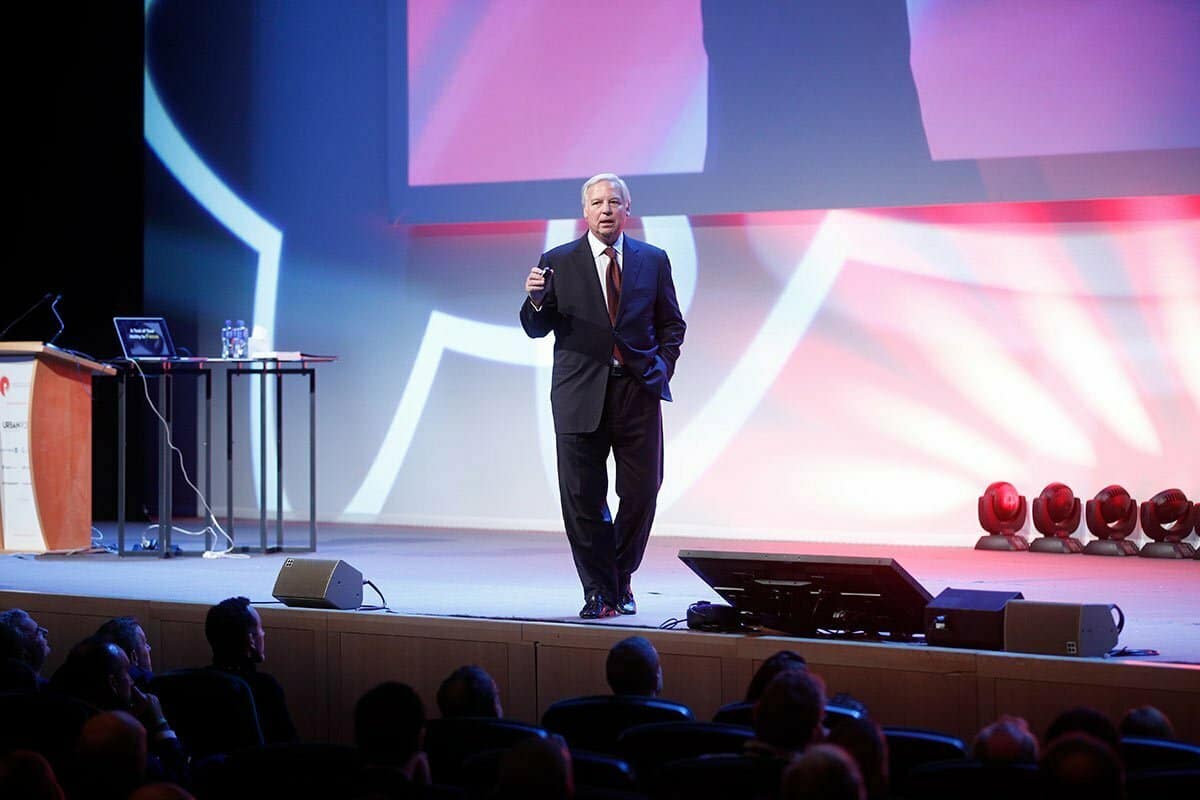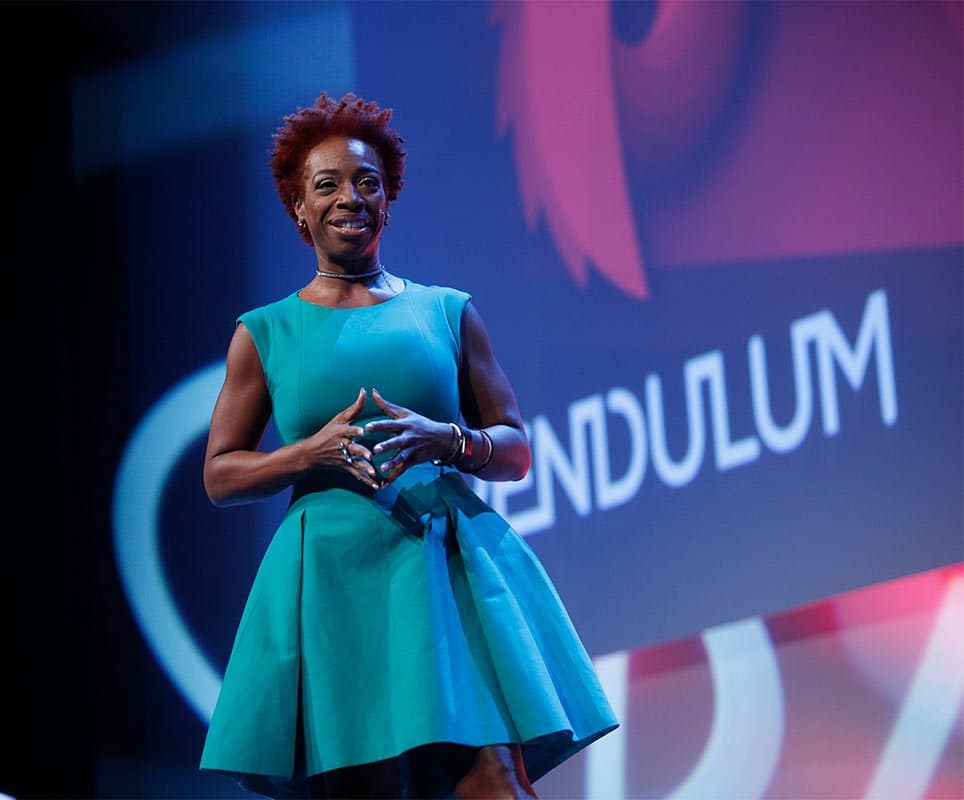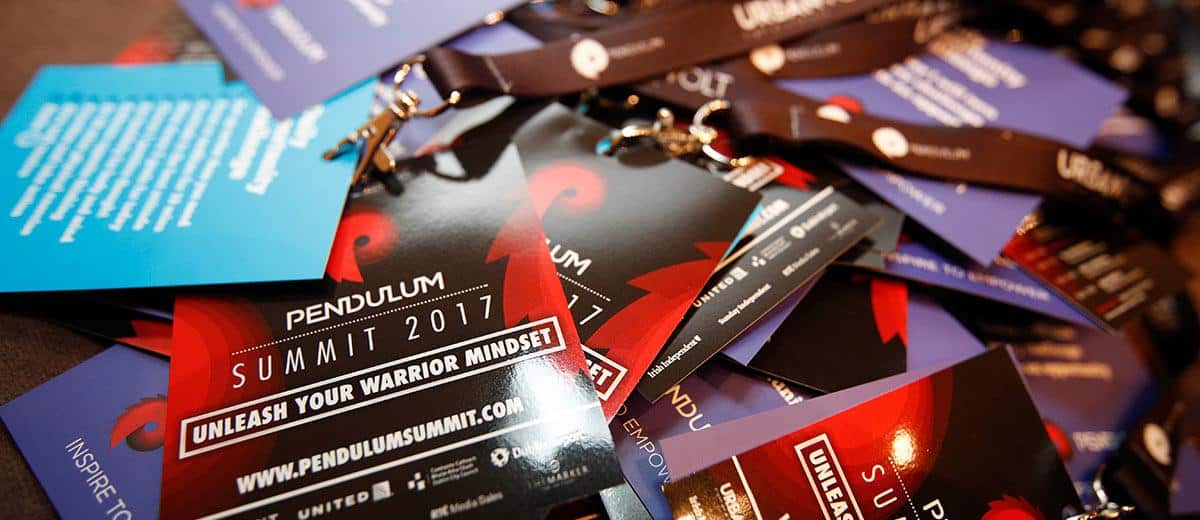This week we are recapping on Marketing and Sales Visionary David Meerman Scott.
A true global mindset born from 10 years working in over 40 countries and on all 7 continents, people rely on David’s sales and marketing strategies and tactics to grow their businesses exponentially. His 10 best-selling books have sold close to a million copies in 29 languages from Albanian to Vietnamese.
David’s eleventh book, Fanocracy, proves that creating fandom is not something reserved just for celebrities, athletes, and authors. Creating a Fanocracy is rocket fuel used by forward-thinking companies and organisations to inspire and nurture true fans.
Organisations impacted by David’s vision at Pendulum Summit learned to win by tapping into this mindset, putting relationships with people above all else. His highly charged presentation inspired delegates to set old ideas and fear aside and use new tools to achieve measurable, no-cost results to turn customers into fans and fans into customers.
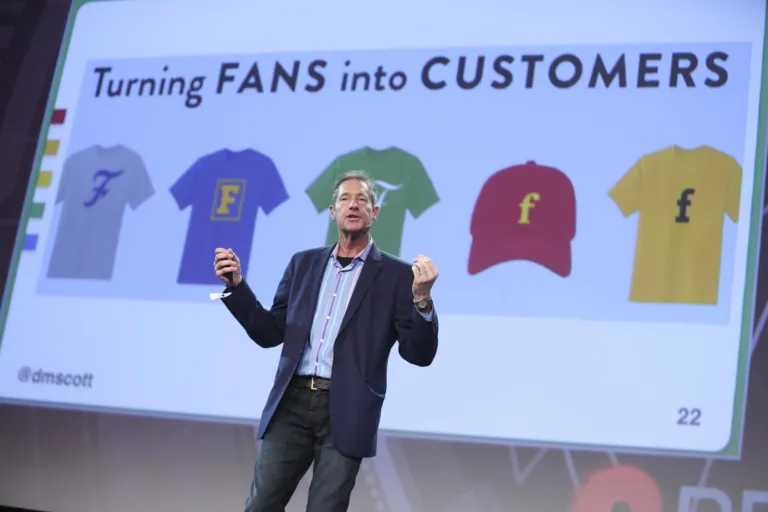
Meerman Scott closed Day 1 of Pendulum 2020, bouncing on to the stage re-energizing the audience for one last evening session. His topic being Fanocracy. He spoke to the audience about his new book, which was released the day before, January 7th 2020, and it’s key learnings. How to make your customers your fans.
Any Company Can Benefit From Fanocracy
Beginning his presentation, he asked the audience about auto insurance, the dreaded notification they get once a year to renew their policy. He told them about a friend of his, he specialises in classic car auto insurance. Instead of going down the usual roots to advertise his business, he decided that they would go to over a hundred classic car events a year. Instead of blindly selling their product to people who may/may not be in the market for it, they’re educating people there. They’re meeting with their customers, they’re engaging with them. They have a magazine that goes out six times a year. They have a YouTube channel, they have a Drivers Club with 600,000 members and that Drivers Club is a place for their members to connect with them and with one another. They built a community of people who love classic cars, a virtual community. They also provide great stuff like roadside assistance like other insurance companies and so on and I love this other thing that they did they recognised that people who love classic cars love to sometimes go to the class of car auctions. What they’ve done in that respect is that they’ve turned fans of classic cars into customers of Haggerty Insurance. And that’s exactly what all of us can do. So my friends at Haggerty Insurance, didn’t have to invent the car and didn’t have to create the passion for classic cars. All they had to do is tap into it.
Everyone can do the very same as David Haggert and Meerman Scott tried to show the audience that. It wasn’t about being the newest product or the most different, it was about understanding your customers and giving them what they want, relating to them and why they use your product/service. He continued that the pendulum has swung too far in the direction of superficial online communications when we’re all hungry for a true human connection. And this idea of the human connection to overcome digital chaos is fandom. It’s relationships with people. It’s exactly what Haggerty is doing cultivating fandom.
How To Develop Fandom
Human Connection
This idea of Fandom is to put customers needs ahead of everything else and that’s how you can build fandom. He shared a number of examples of how to develop fandom with the Pendulum Summit audience during this session. He also shared specific prescriptions that he has learned by researching over 5 years of how one can develop fans in their business irrelevant of what business you’re in, from dentistty, to B to B companies, software companies, consumer product companies and more. His point being that all sorts of businesses can develop fans. ‘The key is to add a true human connection and that will allow that pendulum to swing back to this idea of a human connection and building fans. This is what a fanocracy is. I’d like to do here for just a few moments is share with you a little bit about what I’m a massive fan of and that’s live music.”
Tribe Mentality
This idea of fandom. Neuroscience tells us that it’s a relationship with people that is so powerful. We all want to be part of a tribe. He referenced his daughter Reiko who is a fan of Harry Potter because she’s part of a tribe. She can go to any other Harry Potter fan and say ‘what house are you in?’ Everybody knows what that means and can respond.
He then explained that he loves live music.That’s where he is really comfortable, this is also a tribe of people and he explained that is what one can do in their business. They can create a tribe of people. He referenced the Pendulum Summit team, and the tribe of people they gathered in the Convention Centre for two days of presentations and networking sessions with people who all want to engage in what is being shared at this event and have genuine human connections.
He granted that yes, you could get some of this content virtually, but the physical event was amazing. It is about shared emotion, which is actually a biologically evolved human reaction, which is vital to our survival- this idea of engaging with people. With hundreds and hundreds of companies that have developed this feeling of fandom in their business. Meerman Scott wanted to give the Pendulum audience a prescription for how they can do it right now and develop fans of their business.
Rehumaize
The first way for them to do so is to rehumanize.
This is the idea of making sure you understand deeply the people that you’re selling to. Most organisations focus so much on their products and services and they just talk about themselves to sell those products and services that they’re not listening or being human. Similar to the auto insurance company he spoke about opening his presentation, he stressed that one must listen to their customers and make a connection with them. Don’t just focus on their product or service.
‘I’ve heard their innovative’ Meerman Scott gushes on stage, ‘If you’re using the word innovative to market, you’re not building fans because everybody’s innovative. The word innovative means one thing and that means you are not innovative because everyone else is doing the same thing. So eliminate these ‘gobbledygook’ words from the way you speak.
The importance of being human cannot be underestimated if one is trying to build fans for their business. And there’s another thing he noted that he sees all the time. “I bet you many of your organisation’s are doing this and that’s using these crazy photographs. I mean, I don’t know who the heck these people are? So you need to eliminate these ‘gobbledygook’ photos from your websites, from your marketing materials and from your social media.”
Meerman Scott stated you must eliminate stock photos and to do that you actually use a real photographer. Say no to stock photos- your organisation needs to build meaningful human connection with people in today’s chaotic world and doing so with stock photos doesn’t work.
You Must Be Able To Let Go Of Your Creations
The second prescription is to let go of your creations. The idea here is that once you put your product or service or idea out into the world. It’s no longer yours. Once you put your product or service or idea out to the world it belongs to the fans. Once it is unleashed to the world, it is imperative to let your fans do with it what they would like. You cannot control the way they react with your product or service.
Two Versions Of Fandom
When Meerman Scott studied this idea of fandom, he found two different versions of Fandom, neither is right or wrong. It’s not that one is better than the other they’re just two different types.
Curative Fandom
The first form of fandom is called Curative Fandom. This is the idea of official fandom. It’s the official website, the official social media etc of any given product or service.
Transformative Fandom
Then there’s Transformative Fandom which is taking something and turning it into something new.
And so Merman Scott explained to the audience that they need to make sure that they understand that their customers are doing both of these things. They’re transforming what we create for them and they’re using what we created for them in the way we intended, and ensure we can allow them to do both.
In the Classic Car World, some people love to make their car look exactly the way it did when it came out of the factory 50 or 75 years ago, an example of Curative fandom.
Then you’ve got transformative fandom in the Classic Car World- turning something into a hot rod making it completely different.
Let Your Customers Help Each Other
Trademark our software– My daughter says we all laugh at Adobe because everything that we’re saying sounds like a fan talking but everything Adobe is telling us to do. When developing your own fanocracy, think about the idea that it’s built on, the experiences of your customers. Not just limited to your imagination. Let people share those ideas.
Meerman Scott then explored an example in the B2B World- Microsoft, now the second most valuable company on the planet has a worldwide partner community. How do I use this particular software? How do I set up this particular hardware? The partners jump in and help the other partners. Katie Quigley at Microsoft told me you don’t always want to hear from the company that sold you something. You want to hear from your peers. So this is another idea about building fans. Let go of your creations, let the fans take over, let the peers communicate with one another. Here’s Microsoft’s results- So 95 billion dollars in annual revenue they have 300,000 partner companies in their community, 1.5 million individual partners.
Once You Put Your Product Or Idea Out There It Is No Longer Yours
Meerman Scott again stresses his point- once you put it out there. It’s no longer yours. He continued his presentation with ideas as to how the Pendulum audience can build fans- it’s an easy idea that every single one of us can implement and it’s the idea of getting closer than usual. This is an idea that is rooted in neuroscience. It turns out that humans are hard-wired in their brains to want to become part of a tribe. We want to become a part of like-minded people because when we are part of a tribe we’re safe and secure. It’s very positive human emotions.
If we see people we don’t know, we can’t help but feel that there’s a weird vibe. And so he posed a question to the crowd, ‘How can you cultivate ways for people to be closer to you? literally closer to you physically.”
The Effect Of Proximity
This is the idea of proximity. The closer you get to someone, the more powerful the shared emotions. This is hardwired in our brains as humans, the closer you get to someone the more powerful the shared emotions. Here are the levels of proximity further than roughly 12 feet is called public space. He commented that he was in everyone’s public space- further than 12 feet away from them. Neuroscience tells us our brains don’t track people who are this close to us inside of 12 feet from 12 feet to about four feet. That’s social space, where our brains begin to track people. So when we enter a room, we need to know who these people are.. Are they people I can trust? Are they part of my tribe?
So here at pendulum summit, when we’re even closer than normal. The question becomes, can you get in the personal or social space of your customers? and if you can that becomes incredibly powerful.
He references those in multinational businesses, those with customers all over the world or who run an online business or for whatever reason how it is not possible for them to be in their customer’s space. There’s another concept of neuroscience called mirror neurons that allow you to be able to take advantage of this idea as well. The idea of mirror neurons is when you see somebody doing something, your brain will fire as if you are doing it yourself. He demonstrated this concept on stage for the audience by holding a lemon in one hand and slices of lemon in his other hand. The audience can see the lemon far away as they look at him on the big screens around the room.
He took a bite of this lemon commenting ‘Wow, it’s powerful’. His eyes closed, his mouth puckers up, his saliva glands are watering. It’s tart lemons, really really powerful thing. He announced his brain was firing, he guessed that everybody’s brain was firing just a little bit. Did we all taste a little bit of that lemon? That’s the power of mirror neurons.
How can we use the power of mirror neurons together with the proximity to reach our customers? No matter what business we’re in, we can develop fans by using photographs and video cropped as if you’re in the personal space of the camera, looking at the camera, talking directly to the camera. The idea of using this concept of mirror neurons because our brains tell us that we are in close physical proximity with that person whose photograph or video we see even though it’s just an image on the screen. That’s why we feel we know movie stars and celebrities. For example, Lord Alan Sugar came on stage that morning. Those who watch The Apprentice felt like they knew him as he was interviewed. You don’t know him but your brain tells you, you know him and so you can use this concept in your business. This also explains the idea of the selfie.
Passion Is Infectious
Passion is infectious. When you’re loving life, that rubs off to your customers and people naturally gravitate to you. So many people say, “I don’t mix my personal life and my business life. I’ve got my LinkedIn over here. That’s for my business. I have my other stuff over here. That’s what I do personally. Those things don’t mix.” Think about maybe mixing them a little bit.
Meerman Scott gave an example of this, Dr. Marashi is a dentist with his own practice. He transformed his business social media platforms from the typical mundane dental posts that we expect to see from every dental practice. Photos of gleaming white teeth, patient transformations and dental hygiene tips but he also mixed it with other important elements of his life including his love for skateboarding and his gorgeous young family. He contacted Meerman Scott out of the blue about a month ago. He said “Dave I just had to share with you. This is working so well for me”, he told him that he is growing his business because he said I have this passion and I’m sharing it with the world. This deep passion for what I do and for my family specifically he told me that he has had 30% growth of new patients that he can directly tie to that Instagram feed. Dr. Marashi had 30% growth as a result of building fans. This is the idea of turning fans into customers and customers into fans.
He closed his presentation with the following, Fandom is for all businesses. Meerman Scott told the audience that he has spent five years doing that research and he can absolutely and positively confirm there is no question about it. “Every one of you can build fans of your business. I’ve seen it in all sorts of different businesses and here’s the proof of that. Many times when people become fans of something they want to wear the logo of the thing that they’re a fan of, on a hat, a t shirt, stickers on their laptops or cars, tattoos on their bodies in some cases. And so he displayed numerous images on the large screens around the room of people doing just that. This outward manifestation of fandom and it is what I can’t wait for you to experience when you put out these ideas. Ideas grow fans of your business because there’s no question about it, every single one of us in this room has an opportunity to develop fans in this way. It’s all about building a genuine and personal human connection with your fans and it’s an amazing way for you to grow.
Don’t forget to sign-up to our newsletter to make sure you don’t miss out on any week of this series!


